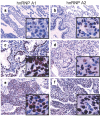Deregulated expression of hnRNP A/B proteins in human non-small cell lung cancer: parallel assessment of protein and mRNA levels in paired tumour/non-tumour tissues
- PMID: 20716340
- PMCID: PMC2933625
- DOI: 10.1186/1471-2407-10-434
Deregulated expression of hnRNP A/B proteins in human non-small cell lung cancer: parallel assessment of protein and mRNA levels in paired tumour/non-tumour tissues
Abstract
Background: Heterogeneous nuclear ribonucleoproteins (hnRNPs) of the A/B type (hnRNP A1, A2/B1, A3) are highly related multifunctional proteins participating in alternative splicing by antagonising other splicing factors, notably ASF/SF2. The altered expression pattern of hnRNP A2/B1 and/or splicing variant B1 alone in human lung cancer and their potential to serve as molecular markers for early diagnosis remain issues of intense investigation. The main objective of the present study was to use paired tumour/non-tumour biopsies from patients with non-small cell lung cancer (NSCLC) to investigate the expression profiles of hnRNP A1, A2/B1 and A3 in conjunction with ASF/SF2.
Methods: We combined western blotting of tissue homogenates with immunohistochemical examination of fixed tissue sections and quantification of mRNA expression levels in tumour versus adjacent normal-looking areas of the lung in the same patient.
Results: Our study, in addition to clear evidence of mostly uncoupled deregulation of hnRNPs A/B, has revealed hnRNP A1 to be the most deregulated protein with a high frequency of over-expression (76%), followed by A3 (52%) and A2/B1 (43%). Moreover, direct comparison of protein/mRNA levels showed a lack of correlation in the case of hnRNP A1 (as well as of ASF/SF2), but not of A2/B1, suggesting that different mechanisms underlie their deregulation.
Conclusion: Our results provide strong evidence for the up-regulation of hnRNP A/B in NSCLC, and they support the existence of distinct mechanisms responsible for their deregulated expression.
Figures




Similar articles
-
HnRNP A1/A2 and SF2/ASF regulate alternative splicing of interferon regulatory factor-3 and affect immunomodulatory functions in human non-small cell lung cancer cells.PLoS One. 2013 Apr 29;8(4):e62729. doi: 10.1371/journal.pone.0062729. Print 2013. PLoS One. 2013. PMID: 23658645 Free PMC article.
-
Relative amounts of antagonistic splicing factors, hnRNP A1 and ASF/SF2, change during neoplastic lung growth: implications for pre-mRNA processing.Mol Carcinog. 2004 Dec;41(4):187-96. doi: 10.1002/mc.20053. Mol Carcinog. 2004. PMID: 15390079
-
Prognostic and diagnostic relevance of hnRNP A2/B1, hnRNP B1 and S100 A2 in non-small cell lung cancer.Cancer Detect Prev. 2006;30(5):395-402. doi: 10.1016/j.cdp.2006.04.009. Epub 2006 Oct 25. Cancer Detect Prev. 2006. PMID: 17067748
-
Heterogeneous nuclear ribonucleoprotein A1 in health and neurodegenerative disease: from structural insights to post-transcriptional regulatory roles.Mol Cell Neurosci. 2013 Sep;56:436-46. doi: 10.1016/j.mcn.2012.12.002. Epub 2012 Dec 14. Mol Cell Neurosci. 2013. PMID: 23247072 Review.
-
A comprehensive understanding of hnRNP A1 role in cancer: new perspectives on binding with noncoding RNA.Cancer Gene Ther. 2023 Mar;30(3):394-403. doi: 10.1038/s41417-022-00571-1. Epub 2022 Dec 2. Cancer Gene Ther. 2023. PMID: 36460805 Review.
Cited by
-
hnRNP A1 antagonizes cellular senescence and senescence-associated secretory phenotype via regulation of SIRT1 mRNA stability.Aging Cell. 2016 Dec;15(6):1063-1073. doi: 10.1111/acel.12511. Epub 2016 Sep 9. Aging Cell. 2016. PMID: 27613566 Free PMC article.
-
Heterogeneous nuclear ribonucleoprotein A/B: an emerging group of cancer biomarkers and therapeutic targets.Cell Death Discov. 2022 Jul 25;8(1):337. doi: 10.1038/s41420-022-01129-8. Cell Death Discov. 2022. PMID: 35879279 Free PMC article. Review.
-
Alternative splicing in cancer: implications for biology and therapy.Oncogene. 2015 Jan 2;34(1):1-14. doi: 10.1038/onc.2013.570. Epub 2014 Jan 20. Oncogene. 2015. PMID: 24441040 Review.
-
Alternative RNA splicing in cancer: what about adult T-cell leukemia?Front Immunol. 2022 Aug 1;13:959382. doi: 10.3389/fimmu.2022.959382. eCollection 2022. Front Immunol. 2022. PMID: 35979354 Free PMC article. Review.
-
ERK1/2-EGR1-SRSF10 Axis Mediated Alternative Splicing Plays a Critical Role in Head and Neck Cancer.Front Cell Dev Biol. 2021 Sep 20;9:713661. doi: 10.3389/fcell.2021.713661. eCollection 2021. Front Cell Dev Biol. 2021. PMID: 34616729 Free PMC article.
References
-
- Carpenter B, MacKay C, Alnabulsi A, MacKay M, Telfer C, Melvin WT, Murray GI. The roles of heterogeneous nuclear ribonucleoproteins in tumour development and progression. Biochim Biophys Acta. 2006;1765:85–100. - PubMed
Publication types
MeSH terms
Substances
LinkOut - more resources
Full Text Sources

